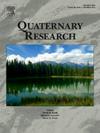在小冰河期对石笋使用非破坏性技术探索马略卡岛洞穴洪水:微型ct和XRF核心扫描
IF 1.8
3区 地球科学
Q3 GEOGRAPHY, PHYSICAL
引用次数: 0
摘要
摘要本研究主要通过两种非破坏性技术(1)高分辨率微计算机断层扫描(micro-CT)和(2)x射线荧光(XRF)核心扫描(XRFCS)表征Seán石笋(4.75-7.75 cm)内部的不连续结构。显微ct法测定石笋密度,XRFCS法测定石笋的元素组成和颜色。通过非破坏性技术获得的新数据已与先前发表的地球化学数据和马略卡岛Sa Balma des Quartó洞穴中发现的同一石笋的织物测定相结合。本研究中采用的两种方法改进了独特视界的表征。由于空气含量高,微ct图像将该层识别为次要事件。独特的层位以高钛含量为特征,表明陆源颗粒的到来。根据这些观测结果,再加上泥晶层填补了旧柱状结构之间的空隙,我们认为泥晶层可能代表了1616±23 CE之后和1623±28 CE之前洞穴内的一次大洪水事件,这可能与一次极端降雨事件有关。2018年秋季观测到的洞穴洪水进一步支持了这一假设。本文章由计算机程序翻译,如有差异,请以英文原文为准。
Exploring a Mallorca cave flooding during the Little Ice Age using nondestructive techniques on a stalagmite: micro-CT and XRF core scanning
Abstract This study focuses on characterizing a discontinuity within the Seán stalagmite (4.75–7.75 cm) by means of two nondestructive techniques: (1) high-resolution micro-computed tomography (micro-CT) and (2) X-ray fluorescence (XRF) core scanning (XRFCS). Micro-CT was used to study the stalagmite density, and XRFCS was applied to obtain the qualitative elemental composition and colour measurements. The new data obtained from nondestructive techniques have been combined with previously published geochemical data and fabric determinations from the same stalagmite found in Sa Balma des Quartó cave in Mallorca. The two methodologies applied in the present study have improved the characterization of the distinctive horizon. The micro-CT images identified the layer as a minor event due the high air content. The distinctive horizon is characterized by a high Ti-content, indicating the arrival of terrigenous particles. Based on those observations, together with the fact that the micrite layer appears filling the gaps between the older columnar fabric, we argue that the micrite layer may represent a major flooding event inside the cave after the year 1616 ± 23 CE and before the year 1623 ± 28 CE, which can be related to an extreme rainfall event. This hypothesis is further supported by the observed cave flooding during the autumn of 2018.
求助全文
通过发布文献求助,成功后即可免费获取论文全文。
去求助
来源期刊

Quaternary Research
地学-地球科学综合
CiteScore
4.70
自引率
8.70%
发文量
57
审稿时长
3 months
期刊介绍:
Quaternary Research is an international journal devoted to the advancement of the interdisciplinary understanding of the Quaternary Period. We aim to publish articles of broad interest with relevance to more than one discipline, and that constitute a significant new contribution to Quaternary science. The journal’s scope is global, building on its nearly 50-year history in advancing the understanding of earth and human history through interdisciplinary study of the last 2.6 million years.
 求助内容:
求助内容: 应助结果提醒方式:
应助结果提醒方式:


